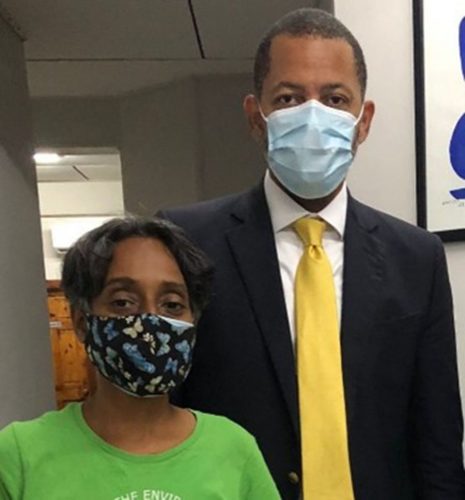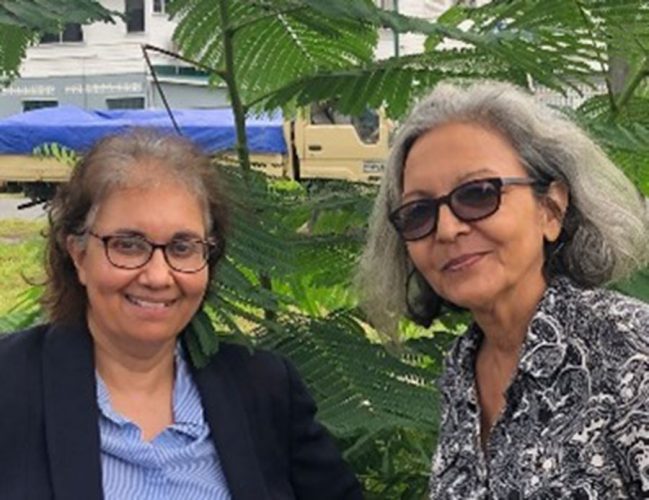Acting Chief Justice, Roxane George SC has ruled in favour of the Environmental Protection Agency (EPA); against which an action was filed to put a stop to flaring of gas offshore by ExxonMobil.
Among other things, the Chief Judge said “there is no evidence that the modified environmental permit (EP) will cause additional adverse effects…”
The Court found that the EPA did not breach the law as was being alleged.
The case surrounded an application for judicial review filed by three Guyanese women— Sinikka Henry, Sherlina Nageer and Andriska Thorington—for the Agency to cease gas flaring.

The litigants had asked for orders directing the EPA to provide reports on the amount of gas flared, and the toxins released.
They were also asking for an independent and expert probe of Esso Exploration and Production Guyana Ltd’s (EEPGL) compliance with manufacturer’s standards for operating its gas compressor.
Their contention had been that that Esso, an offshore company wholly owned by ExxonMobil, has been flaring associated gas almost continuously since it began production in December 2019, despite undertaking to reinject the associated gas, not flare it.
In May 2021 after ExxonMobil had flared billions of cubic feet of associated gas, the EPA purported to modify Esso’s permit to allow it to flare gas.
The litigants also argued that the Agency’s decision to modify Esso’s environmental permit to allow flaring was irrational and unlawful and that it should be quashed by the Court. They also argued that the Agency breached the Environmental Protection Act Cap 20:05 by purporting to allow Esso to flare in return for paying a fee.
The three alleged that the EPA acted in breach of the law when it decided to modify the EP issued for the Liza 1 Petroleum Development Project.
They also contended that the EPA’s decision to charge US$30 per tonne of carbon dioxide equivalents emitted as set out in the modified Permit was in breach of the polluter pays principle.
In responding to the claims, the EPA maintained that its decision to modify the Permit was made because the unmodified Liza 1 Permit had only prohibited routine flaring.
The Agency had said that in that form, it did not consider or regulate ‘flaring which was not routine.’
It contended that having recognised this gap, it made the decision to modify the Permit in order to set out the conditions that would govern flaring that was ‘not routine’.
Further to this, the EPA advanced that it had moved to apply the polluter pays principle in order to require ExxonMobil Guyana Limited to bear the cost of ensuring that the environment remained in an acceptable state in keeping with the Environmental Protection Act.
In handing down her ruling, the Chief Justice underscored that during the proceedings, the Applicants abandoned a number of the reliefs they had requested for lack of evidence.

The Court also noted that the Applicants had adduced no evidence to substantiate the remaining reliefs requested.
She said it was not evident from the case for the Applicants, how the regulation was breached; while adding that there was no evidence that the modified EP will cause additional adverse effects outside of the first applicant’s opinion in this regard.
She also noted that there is no evidence that the original EP relied on by the applicants, which permitted flaring placed any restriction on flaring over and above that which is also included in the modified EP.
The Judge went on to note in her written judgment seen by this newspaper, that the fact the Act provides for the polluter pays principle, indicates that there is a recognition that there will be some adverse environmental effects which must be paid for.
Ultimately finding in favour of the Agency, Justice George said the evidence proffered was “confusingly expressed” and consisted of a lot of opinions, either advanced by the applicants or advice given by their lawyers.
The Judge said that the Applicants were cherry-picking what they wanted to rely on to support their case, identifying and relying on clauses or parts in isolation. The documents she said, however, have to be read holistically and not by focusing on paragraphs that either modified or explained what was meant to be the standard.
She pointed out, too, the fact that the Applicants mounted their challenge on January 24th, 2022, some eight months after the issuance of the modified permit which was set to expire on May 31st, 2022.
Justice George underscored that it was not explained why the Applicants delayed in so applying.
Against this background she said that since the application was filed to challenge a permit which was going to expire in what was then about two weeks from the date of hearing, it meant that in reality any decision would be purely academic.
Therefore, of the 23 prayers for relief including costs, the Applicants she said, in actuality only sought five which their lawyers sought to modify from the claims for orders certiorari and mandamus to claims for declarations since the permit was then about to expire.
The Chief Justice had also noted the contention of the Applicants that in the absence of reasons, the decision to modify the EP was irrational, unreasonable, arbitrary and therefore unlawful.
She said, however, that in the factual context of the case it was unclear to whom the EPA would have given such reasons other than Esso. There is no evidence that there was a breach of the consultation requirements in relation to the issuance of the EP, the Judge noted.
The Chief Justice said that while the Applicants cite Esso’s environmental impact assessment (EIA) under clause 2.16.2 – Development Concept Alternatives; it has to be appreciated that this does not prohibit flaring and refers to “continuous flaring of gas on a routine basis is not preferred, primarily due to the associated air emissions.”
Justice George said the fact that counsel for the Applicants had written the EPA on April 30, 2021, stating that Esso’s flaring was illegal, and asking the Agency to confirm the amount of gas that was flared and steps the Agency was taking to stop Esso from flaring above pilot levels “does not prove their claim.”
Further, she said that the Applicants make a quantum leap, without evidence, to say that in response to the lawyer’s letter the EPA issued the modified EP. The letter she said, “cannot be considered as evidence of flaring, whether routine or not.”
The Judge further went on, “Indeed, the original EP is open ended regarding both routine and non-routine flaring while the modified EP fixes a timeframe for flaring beyond which there would be a fee charged. As such there has to be a comparison of the original permit and the modified permit in relation to the provisions for flaring. It does appear that, on this issue, the applicants have not correctly interpreted the original permit. The original permit does not prohibit flaring as the applicants want to suggest. In fact, the modified permit states that but for the exceptions stated therein, routine flaring is not just prohibited, but is strictly prohibited.”
In all of the circumstances, the Chief Justice ruled that the EPA’s act of issuing the modified EP to Esso “has not breached the EP Act and the Regulations. Nor has it been proven that the issuance of the said modified EP gave rise or has given rise to an additional adverse effect on the environment.”
“There is nothing in the law that prevents the issuance of a modified EP; and in this case, nothing on the facts rendered the issuance of the modified EP unlawful,” Justice George said; while adding that the EPA’s implementation of the polluter pays principle in the modified EP is in compliance with the Act.
In addition to dismissing the application, the Judge awarded the Agency costs in the sum of $150,000 to be paid no later than November 3rd, 2023.
The Environmental Protection Agency was represented by attorneys Frances Carryl, Shareefah Parks and Niomi Alsopp.
Meanwhile, the litigants were represented by Senior Counsel Seenauth Jairam and attorneys Melinda Janki and Ronald Burch-Smith.






